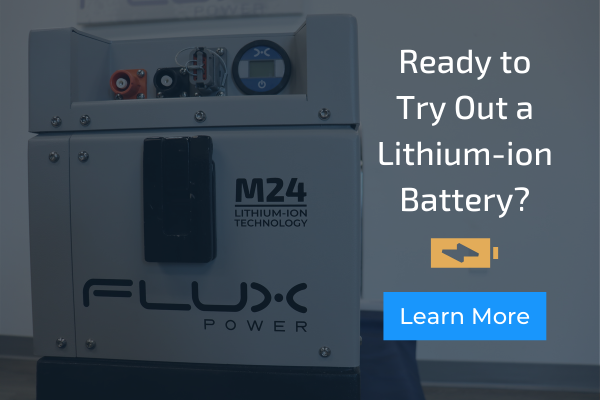#1 Lithium-Ion Power Helps Improve Operational Efficiency
A lithium-ion-powered forklift fleet can dramatically improve your operational efficiencies such as:
- Uptime from opportunity charging
- No maintenance unlike lead acid batteries
- Insights from data that can help improve inefficiencies
Unlike other forms of forklift power (i.e., lead acid batteries, internal combustion), lithium-ion power gives you the ability to reduce inefficiencies. Using lithium-ion batteries can reduce inefficiencies like ergonomic and environmental hazards due to having no maintenance and easy charging capabilities. There are a few different features of lithium-ion batteries that can give you this ability.
Opportunity charging
Gone are the days of having to take a piece of equipment out of your rotation because the battery needs to charge. Opportunity charging allows batteries to be charged for shorter periods of time throughout the day, as opposed to a full charge in an extended amount of time.
Lead acid batteries must be fully charged each time to make sure you get the longest lifespan. The charging process for lead acid batteries can take up to eight hours (plus an additional 8 hours for cooldown). Lead acid batteries are also labor-intensive. Operators typically must remove the batteries from the lift truck and charge in a designated room. Lead acid batteries must be charged in a separate charging room because the harsh fumes need ventilation. Once those batteries start charging, charged replacement batteries need to be installed to keep production going. This charging practice is commonly known as battery swapping.
Opportunity charging a lithium-ion forklift battery gives the ability to charge at the operator’s convenience. Lithium-ion batteries do not require a full charge like lead acid batteries. This means you can schedule the charging around business production needs. Operators can even charge while on planned downtime (like breaks).
Preventative maintenance
From a maintenance perspective, lead acid batteries need to be monitored for water levels and equalization of the cells. Lead acid batteries need to be checked for spills, corrosion, and overcharging, which means warehouse workers are at higher risk of injury. Batteries with higher maintenance requirements can pose a risk to labor workers in the warehouse.
Alternatively, lithium-ion batteries for forklifts do not require the same maintenance as lead acid batteries. Instead, lithium-ion batteries have a battery management system that may have an optional telematics unit that alerts operators if a battery has a low state of charge or if there might be a possible issue with the battery.
Telematics/BMS
Lithium-ion batteries come with built-in battery management systems (BMS) and when integrated with a telematics unit extension, can give you deeper insight into the fleet. BMS monitors the overall state of the forklift battery. It can even monitor cell temperatures to make sure they stay within a safe operating range.
Using lithium-ion technology with a telematics unit can benefit warehouses by providing data that can help optimize operator practices. Adopting lithium-ion battery solutions into forklift fleets can help fleet directors reach their operational efficiency goals.
#2 Increased Efficiencies Can Highlight Areas of Opportunity
Small inefficiencies are sometimes harder to spot because operations are always too busy fighting larger ones. Thanks to lithium-ion technology, businesses can start eliminating both big and small inefficiencies in their process and turn the business into a well-oiled and fine-tuned machine. For example, operations improve uptime thanks to opportunity charging. This can highlight capacity within the operation that can be better maximized for peak ROI.
Or maybe the telematics data reveals that operators don’t need as many lift trucks as originally thought. As a result, you may be able to reduce the size of the forklift fleet if the overall uptime improves.
The BMS, along with an integrated telematics unit on a lithium-ion battery pack, can also send notifications to forklift operators alerting them of any potential issues such as a low state of charge, temperature warnings, and more. A battery with a BMS benefits operators and assists in increased operational efficiency.
Lithium-ion battery technology can reveal deeper insights into areas of opportunities such as identifying over or under-utilized batteries to optimize operator practices. Discovering these new areas of opportunity leads to achieving those operational efficiency goals.
#3 Invest in a Longer Lifespan for Your Fleet with Lithium-ion Batteries
It is crucial for fleet directors to invest in the longest lifespan possible for forklift batteries. By investing in batteries with a longer lifespan, operations can decrease their total cost of ownership.
Operations can get nearly double the lifespan out of a lithium-ion battery compared to a lead acid battery. Lead acid batteries need a full charge when the SOC gets low. On the other hand, lithium-ion battery packs can be opportunity charge which maximizes the battery’s cycle life.
In the end, the true cost of a battery isn’t just about the up-front purchase price. Fleet managers must consider all the costs down the road. The following factors are important to assess when purchasing a battery for a forklift.
Downtime
Hidden, small increments of unplanned downtime are hard to spot without telematics. A BMS with telematics can provide insightful data that detects downtime of forklifts.
Inefficiencies
Charging a lead acid battery tends to happen during the busy season when operating at peak production is the worst time to take a forklift out of service. Lead acid batteries require extensive charge times which can contribute to inefficiencies. On the other hand, lithium-ion battery packs have shorter charge times which means equipment is out of service for a less time eliminating these inefficiencies that happen with their lead acid counterpart.
Safety risks
Poor ergonomics can lead to safety incidents, which can be costly for both employer and employee. It is vital to have a battery solution that does not pose a safety risk in the warehouse environment.
Maintenance costs
How much does it truly cost to maintain your batteries? Watering, charging, and inspecting batteries all take time and labor. Having reduced maintenance costs can help to move the extra capital where it is needed in operations.
Lithium-ion batteries are the solution for forklift fleet management. They will help you get the longest lifespan possible and ensure operations are not wasting unnecessary downtime.
Support Thriving Operations with a High-Efficiency Forklift Fleet
A fleet director’s top priority is forklift fleet management. They are focused on efficiency and minimizing downtime. Fleet directors are essential in making all the lift equipment run smoothly in a warehouse.
Lithium-ion technology is the best forklift battery to help fleet directors achieve warehouse and operation efficiencies. The benefits of using lithium-ion can help attain those operational efficiency goals. Fleet directors can improve operational efficiencies by adopting lithium-ion batteries into their forklift fleet.












